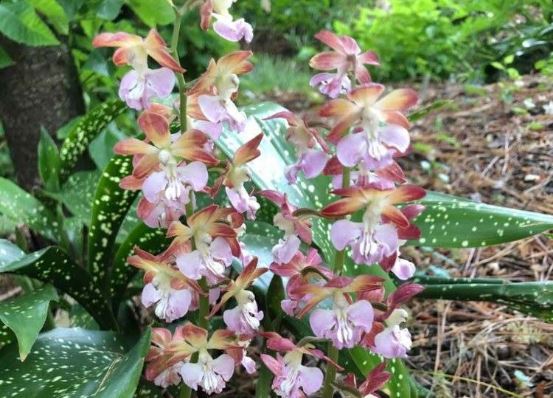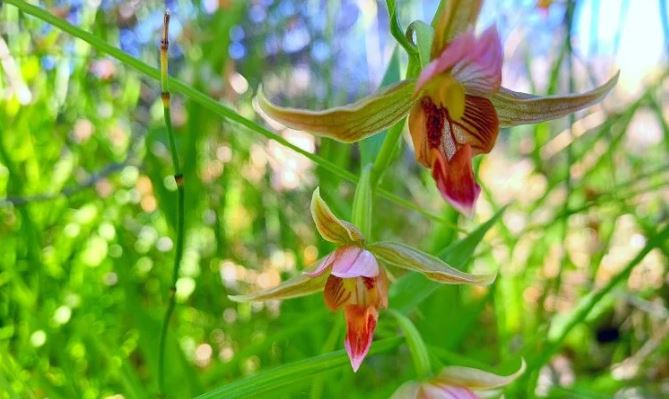
Orchids are the most popular exotic houseplants. Most varieties are very sensitive to frost and cannot survive the winter outside. But even in summer, only a few of the permanent bloomers feel comfortable on the terrace or balcony. If you want to enjoy their filigree flowers outdoors, you should opt for garden orchids. We explain how to plant and properly care for the garden orchids.
What is a terrestrial orchid and which varieties feel particularly comfortable in the home garden?
Most people consider orchids to be exotic flowers that are only suitable for growing in containers. It is true that the most well-known varieties come from tropical areas. But actually, the family is spread all over the world. There are also several native species in Europe. These are referred to by the collective term terrestrial orchids or garden orchids. In contrast to the exotic species from South America, the terrestrial orchids do not need a special substrate, but also get along well with conventional potting soil.
Which orchids are hardy?
The lady’s slipper is perhaps the best-known garden orchid. The broad-leaved orchid also belongs to the plant family Orchidaceae. Furthermore, specimens of the genus Pleione are interesting for hobby gardeners. Exotic plants, such as some varieties from the Bletilla genus that come from Asia, also feel at home in the garden. At first glance, the Stendelwurz do not look like orchids. But if you take a closer look, you will notice the typical flower shape and recognize that it is a plant genus from the Orchidaceae family.
The following terrestrial orchids are hardy:
- Bletilla formosana: An exotic species found in Taiwan, Japan, and China.
- Bletilla ochracea “Chinese Butterfly”
- Bletilla striata (Japanese orchid), varieties “Alba”, “Albostriata”, “Big Bob”, “Junpaku”
- Calanthe discolor, cultivars “Eco Rose” “Eco White”
- Terrestrial orchids Calanthe reflexa
- Garden orchids Calanthe nipponica
- Outdoor orchids Cremastra appendiculata
- Calopogon tuberosus (grass pink)
- Dactylorhiza (Orchid)
- Cephalanthera
- Epipactis ‘Serpentine NightG’
The lady’s slipper is one of the most popular outdoor orchids in this country. Like all other native terrestrial orchids, it is also a legally protected species. However, there are dealers who sell the rarities. When buying, however, you should always make sure that the dealer is certified.
Planting garden orchids: When is the right time?
Garden orchids plant and care for which location and soilView in galleryLike their exotic relatives, garden orchids are planted after the end of the flowering period. Late summer and early fall are best for this when the flowers are dormant and the weather is still warm. This gives them enough time until next spring to develop their roots and recover.
The right location for the terrestrial orchids
The outdoor orchids prefer a sunny to semi-shady location and, like their relatives from Asia and South America, can hardly tolerate direct sunlight. They are best suited as border plantings in flower beds and for planting under trees and shrubs.
Planting garden orchids: Which soil for outdoor orchids?
Care tips for lady’s slipper orchids in the Gardenview gallery-like exotic species, native orchids do not have aerial roots. They, therefore, do not need an orchid substrate, but can easily thrive in potting soil. It is particularly important that the soil is airy and rich in nutrients. You can therefore first loosen it and enrich it with compost and only then plant the plants in the ground. Furthermore, good drainage is an absolute must, because the outdoor orchids cannot tolerate waterlogging. If the garden soil is loamy, you can mix it with medium-grain building sand. However, not every sand is suitable – quartz sand is too fine and can even worsen the permeability.

How do water and fertilize the orchids in the garden?
Water requirements can vary greatly from species to species. However, all garden orchids have one thing in common: They need more water during the flowering period and have to be watered more often. In the garden centers, you can find special fertilizers for orchids. These are usually diluted. Fertilize after every watering. When the outdoor orchids sprout in spring, it is the right time to provide them with slow-release fertilizer to promote flowering.
When do outdoor orchids bloom?
The flowering period for most outdoor orchids begins as early as April, the flowering period extends into early summer and usually ends in July. Of course, the flowering time can vary depending on the species and variety.
Planting garden orchids: summary
The garden orchids fascinate with their filigree flowers and are in no way inferior to their relatives from Asia and South America when it comes to blooming. However, they have one big advantage: they are hardy and can spend the cold season outside. The native terrestrial orchid species have similar requirements in terms of location as indoor plants. A place in the light shade is best, for example under a tree or tall shrub. The soil should be rich in humus, permeable, and moderately moist. The orchids are watered as needed, fertilized once before the start of the garden season, and then after each watering. With good care, the perpetual bloomers thank you with many filigree flowers.